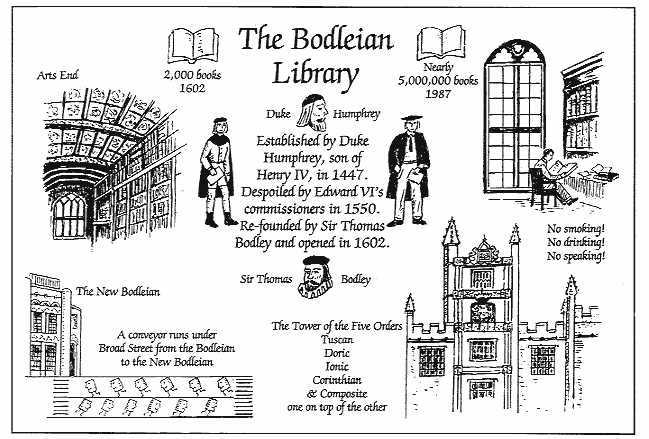 |
Duke Humfrey's Library
In the
last two weeks I have been utilizing the online Swinburne library catalogue to
see what I could find regarding the different aspects of my research topic.
Although some links have not been particularly useful, or accessible when followed
as they took me to journals that I was not able to access, some links and
resources were quite useful.
My
research findings have led me off on tangents which I have found fascinating .
The Bodleian is the main thrust of my assessment; however both the Oriel and
Duke Humfrey’s library were important for their contributions as standalone
libraries and in their contribution to the establishment of the Bodleian. Duke
Humfrey’s library was denuded in 1550 beyond a recoverable point.
Oriel
Although I will not be discussing the Oriel in more in-depth detail, I want to mention a link that, if you're interested in the Oriel and its history, you might find rewarding: http://www.british-history.ac.uk/report.aspx?compid=63876
Back to Duke Humfrey's Library
For a
brief view of the insides of Duke Humfrey’s library have a look at this video: http://www.youtube.com/watch?v=JgyqZXMLMdM.
Duke
Humphrey of Gloucester was the youngest son of Henry IV. He was interested in
patronizing learning, collecting manuscripts and adding to Universities through
gifts. It’s been considered that Oxford University’s decision to build a new library
over the Divinity School occurred because Duke Humfrey donated so many
manuscripts to the original Oriel library in St. Mary’s that the room couldn’t
hold them all. The new room was completed in 1480 and formed the central part
of the overall reading-room.
The conditions of the library above the Divinity
School seemed unmanageable to a certain extent; these motivated the authorities
at Oxford request funding for increased library space. They directed this
petition to the Duke of Gloucester, Humfrey. In their petition they noted that 'should any student, be porting over a single vollume, as often happens, he keeps three or four others away on account of the books being chained so closely together"(Annals of the Bodleian Library, 7 cited in Clark, 171). At this stage in history, similar to many new libraries, this library needed to make better use of space, and as a result a new more useful method of storing books came into being. (University Libraries in the 12-15th centuries: Growth and Development, online.sfsu.edu/~fielden/oxcam/oxford3.doc).
In
1550, ‘commissioners’ were sent by King
Edward VI ‘in the spirit of the Reformation’ to denude the Duke Humfrey
library. Augustine Birrell’s comment ‘for
a long while the tailors and shoemakers and bookbinders of Oxford were well
supplied with vellum, which they found useful in their respective callings. It
was a hard fate for so splendid a collection…the books and manuscripts being
thus dispersed or destroyed, a prudent if unromantic Convocation exposed for
sale the wooden shelves, desks, and seat of the old library, and so made a
complete end of the whole concern, thus making room for Thomas Bodley’ (In the Name of the Bodleian and
Other Essays) referred to the destruction of this library that occurred
after a ‘visitation by Richard Cox, Dean
of the newly-founded Christ Church’. King Edward VI had passed legislation
designed to ‘purge the English church of
all traces of Roman Catholicism, including ‘superstitious books and images’.
Anthony
Wood, a historian, suggested that ‘some
of those books so taken out by the Reformers were burnt, some sold away for
Robin Hood’s pennyworths, either to Booksellers, or to Glovers to press their
gloves, or Taylors to make measures, or to Bookbinders to cover books bound by
them, and some also kept by the Reformers for their own use’.( http://www.bodleian.ox.ac.uk/bodley/about/history,
viewed 15 October 2012). Ultimately, the original Duke Humfrey’s library was
destroyed by these actions and Oxford University did not have the money to
recover the losses they suffered through these actions.
The most
difficult task has been to find in-depth information on the aspects that
interest me, from more than a couple of resources. This may be my research
method.
I look forward to writing my next entry for this blog.
References
‘Bodleian Library and Radcliffe Camera’, History of the Bodleian (2011) URL: http://www.bodleian.ox.ac.uk/bodley/about/history
Date accessed 15 October 2012
URL: http://www.youtube.com/watch?v=JgyqZXMLMdM Date accessed: 15 October 2012
‘In the Name of the Bodleian and Other Essays’ (2004) URL:http://www.gutenberg.org/files/12244/12244-h/12244-h.htm Date accessed: 20 September 2012
'Oriel College and St Mary hall', A History
of the County of Oxford: Volume 3: The University of Oxford (1954), pp. 119-131. URL: http://www.british-history.ac.uk/report.aspx?compid=63876
Date accessed: 18 September 2012
‘University Libraries
in the 12-15th Centuries: Growth & Development’(2005) URL: online.sfsu.edu/~fielden/oxcam/oxford3.doc
Date accessed: 23 September 2012
|
Monday, 15 October 2012
Duke Humfrey's Library
Subscribe to:
Post Comments (Atom)
No comments:
Post a Comment